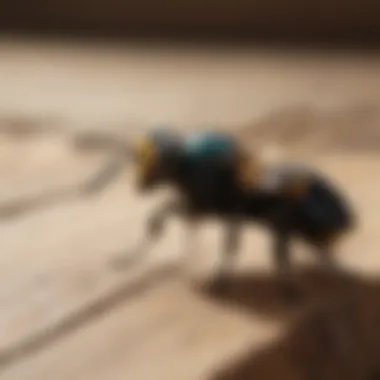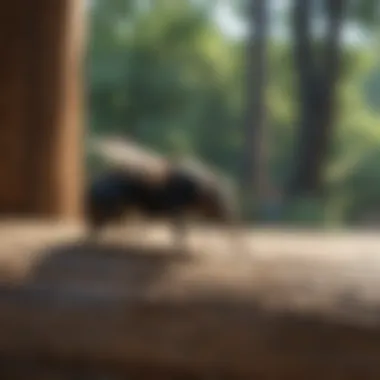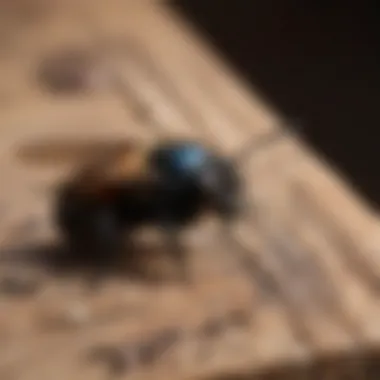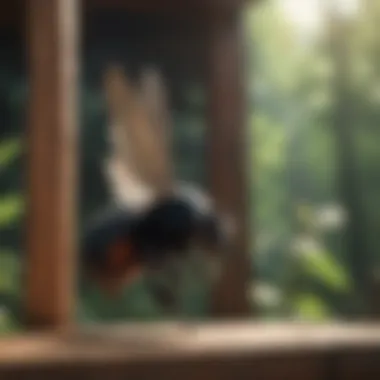Natural Solutions to Combat Carpenter Bees Effectively


Intro
Carpenter bees are a growing concern for many homeowners. These insects, while not aggressive, create nests by boring into wood, leading to potential damage in wooden structures such as decks, fences, and homes. It is essential to address their presence effectively, particularly if you prefer to avoid synthetic chemicals often associated with pest control.
This guide aims to provide a comprehensive overview of environmentally friendly methods to manage and eliminate carpenter bees. Understanding their behavior and biology is crucial, as it allows for targeted strategies that do not harm the environment or beneficial insect populations. With sustainable practices, homeowners can maintain the integrity of their properties while promoting ecological balance.
Understanding Carpenter Bees
Carpenter bees, resembling bumblebees, are often mistaken for them. They are solitary insects, meaning they do not form colonies like honeybees. Instead, females bore into wood to lay their eggs, which can lead to significant issues over time. On the outside, their nesting holes can be small and may go unnoticed until substantial damage occurs.
By recognizing the signs of carpenter bee activity, such as the presence of wood dust or small holes in wooden structures, homeowners can take proactive measures. Sensing their impact early is key to implementing effective control methods.
Natural Deterrents
In order to combat carpenter bees, consider using natural ingredients that deter them without posing risks to other wildlife or pets. These methods are not only effective but also align with sustainable living practices.
- Essential Oils: Some scents like citrus, peppermint, and tea tree oil can repel carpenter bees. Mixing these with water and spraying the mixture around wooden structures may deter their nesting habits.
- Vinegar Solutions: Vinegar is an effective natural insect repellent. A solution of vinegar and water can be sprayed on areas where carpenter bees are likely to nest.
- Cinnamon: Sprinkling cinnamon powder in nesting areas can also deter these insects, as they dislike the scent.
"The use of natural deterrents respects the ecosystem while addressing pest concerns effectively."
Additionally, maintaining a clean environment around potential nesting sites is crucial.
Preventive Measures
Taking preventive steps can significantly minimize the risk of carpenter bees invading your property. Consider the following:
- Wood Treatment: Paint or stain wooden structures. Carpenter bees prefer untreated wood. Sealing any exposed wood can significantly reduce the likelihood of nesting.
- Physical Barriers: Install screens or nets over areas prone to infestation.
- Regular Inspections: Periodically check wooden structures for signs of new activity or damage.
By integrating these methods into your maintenance routine, you can create an inhospitable environment for carpenter bees.
Epilogue
Carpenter bees pose a unique challenge for homeowners, but they can be effectively managed through understanding and preventive measures. By implementing natural solutions and maintaining vigilance, homeowners can enjoy their outdoor spaces without the risk of damage caused by these insects. This comprehensive guide offers the tools needed to create a harmonious relationship with the environment while proactively ensuring the safety and integrity of your wooden structures.
Understanding Carpenter Bees
Understanding carpenter bees is crucial to addressing their presence effectively. These insects are not just a nuisance for homeowners; they can cause significant structural damage if left uncontrolled. Knowledge of their biology, behavior, and how they differ from other bee species can equip homeowners with the necessary tools to manage infestations.
Biology of Carpenter Bees
Carpenter bees belong to the genus Xylocopa and are noted for their robust size and striking appearance. They primarily target untreated wood for nesting, which includes wooden structures, fences, and decking. Males do not sting, while females can sting if provoked; however, they usually prefer to avoid confrontation. Carpenter bees have a unique method of boring into wood, creating tunnels that can compromise the integrity of a structure. Understanding their biology helps in recognizing their potential impact and the need for timely intervention.
Behavior and Nesting Patterns
Carpenter bees exhibit specific behaviors that characterize their nesting patterns. Typically, solitary in nature, females create tunnels in wood to lay eggs. These tunnels can extend several feet in length and are often reused season after season. With each entrance, a female will create a series of chambers, each containing an egg and food supply. Males patrol the area near the nests to defend against intruders, creating a false sense of danger for homeowners. Awareness of these behavioral traits is essential for identifying and addressing infestations effectively.
Distinguishing Carpenter Bees from Honey Bees
Distinguishing carpenter bees from honey bees is important for proper identification and management. While both insects are important for pollination, they have notable differences. Carpenter bees have a more robust and shiny abdomen, lacking the hairs found on a honey bee’s body. Their size is also greater, often resembling bumblebees. Additionally, carpenter bees do not live in colonies like honey bees but are solitary. Identifying them correctly ensures homeowners can take appropriate actions tailored to their nesting habits.


Identifying Carpenter Bee Infestation
Understanding how to identify carpenter bee infestations is crucial for effective management. These bees can cause significant structural damage to wooden structures if left unchecked. By recognizing the early signs of their presence, homeowners can take timely action to mitigate any potential harm. This section will discuss the specific indicators that carpenter bees are nearby and where these infestations typically occur, thus equipping readers with knowledge to safeguard their properties.
Signs of Presence
Identifying the signs of carpenter bee presence is key in preventing damage. Here are some typical indicators:
- Holes in Wood: Carpenter bees create round holes, usually around half an inch in diameter, in wooden surfaces. These holes may appear as clean and smooth, distinct from those made by other insects. The holes often lead to tunnels where they nest.
- Wood Shavings: After a bee makes its hole, it will expel wood shavings. These resemble sawdust and can often be found beneath the nesting site. A noticeable accumulation of shavings signals active nesting.
- Buzzing Sounds: If you hear a buzzing noise near wooden structures, it might indicate the presence of carpenter bees. The sound typically arises when the bees are emerging or entering their nests.
- Sightings of Bees: During the spring months, adult carpenter bees are more visible as they search for suitable nesting locations. These bees appear robust and often sit on wooden surfaces, allowing for easy identification.
Each of these signs should prompt homeowners to inspect their property to determine the extent of the infestation.
Inspecting Common Areas of Infestation
When it comes to carpenter bees, certain areas of the home are more susceptible to infestation. Knowing where to inspect can help address the situation before it escalates. Here are some common areas to check:
- Decks and Porches: These wooden structures are often targeted by carpenter bees due to their exposure to sunlight and warmth, which are ideal for nesting.
- Siding and Fascia: Homes with untreated or weathered wood siding can attract carpenter bees. Be sure to check for holes along the corners or edges of your siding.
- Eaves and Roof Overhangs: Carpenter bees prefer areas that provide shelter. So, inspect under roof overhangs where they may be attempting to nest.
- Wooden Furniture: Outdoor furniture made of wood can also be a target. Look for signs of damage or holes in these items, especially those left exposed to the elements.
"By regularly inspecting areas where carpenter bees are likely to nest, you can identify problems before they become serious, protecting both your home and wood structures."
Regular inspections during the spring and summer months will help in catching carpenter bee infestations early. Swift and informed actions can preserve the integrity of your wooden structures and ensure that your outdoor spaces remain safe.
Natural Repellents for Carpenter Bees
Natural repellents play a crucial role in managing carpenters bees, offering alternative solutions that align with eco-friendly principles. Understanding their efficacy not only aids in eliminating these pests but also ensures that one minimizes harm to the environment. Homeowners searching for practical means to protect their wooden structures will benefit greatly from natural dissuasives, which do not rely on harsh chemicals that can be detrimental to beneficial insect populations. The following discussions delve into specific natural repellents, particularly essential oils and vinegar solutions, which have been found effective in deterring carpenter bees.
Essential Oils as Deterrents
Essential oils are commonly recognized for their aromatic properties, but many also possess insect-repelling qualities. Using these oils can provide homeowners with a natural method to manage carpenter bees effectively.
Peppermint Oil
Peppermint oil is favored for its strong scent, which is particularly potent against carpenter bees. The strong aroma disrupts the bees' ability to locate nesting areas. This is effective, as it masks scents that might attract them. In addition, peppermint oil is generally safe for humans and pets, making it a beneficial choice for households. However, it must be applied regularly as the scent dissipates over time.
Citrus Oil
Citrus oil, derived from oranges or lemons, has also gained popularity among natural pest control advocates. Its fresh scent repels carpenter bees effectively. The acidity of citrus oil can be an unpleasant experience for these insects, potentially driving them away. Its appeal lies in its pleasant aroma, making it more desirable for use around the home. Nevertheless, like peppermint oil, citrus oil needs frequent application to maintain its repellent properties.
Clove Oil
Clove oil is another option for homeowners looking to deter carpenter bees. The oil's strong, spicy scent serves as an effective deterrent. It has the added benefit of being a natural insecticide, which can help in eliminating bees if they come into direct contact with it. Clove oil is also a non-toxic substance, thus safe to use in various settings. However, its intense scent may not be as universally pleasant to some individuals.
Vinegar Solutions
Vinegar is a well-known household item that can also serve as a potent natural repellent against carpenter bees. Mixing water with white vinegar creates a solution that can be sprayed directly on areas where carpenter bees are present. The pungent scent irritates and repels them. Unlike essential oils, vinegar is typically in abundance and easy to apply, which makes it a convenient option for homeowners. Regular spraying is required to maintain its efficacy, particularly after rain or wind that could wash away the solution.
Physical Barriers and Exclusion Techniques
Physical barriers and exclusion techniques are essential in managing carpenter bees, offering an essential first line of defense. These methods prevent the bees from nesting and infesting wooden structures, minimizing potential damage. By implementing these strategies, homeowners can significantly reduce the chance of an infestation, ensuring that their properties remain safe and intact.
Sealing Entry Points


One of the most straightforward methods to control carpenter bees is sealing their entry points. Most commonly, these bees create nests in wooden structures with existing holes. Thus, identifying and sealing those entry points is vital. Homeowners should regularly inspect their properties for any signs of drilling and nesting, particularly in untreated wood.
To effectively seal the entry points, follow these steps:
- Identify Holes: Look for round holes about half an inch in diameter. These are signs of carpenter bee activity.
- Remove Old Residue: Clear out any debris from the nest. This helps prevent other pests from using the same entryways.
- Use Suitable Sealants: Choose appropriate materials like wood putty, caulk, or even epoxy. Ensure the sealant is resistant to the elements to offer longer-lasting protection.
- Paint or Stain Wood: Once sealed, painting or staining wooden surfaces serves as an additional deterrent, making it less appealing for the bees to re-nest.
Implementing these steps not only protects the structure but also reduces the aesthetic impact of potential damage.
Choosing Bee-Resistant Wood
Selecting materials for construction or renovation has significant implications for carpenter bee infestation. Opting for bee-resistant wood types can effectively lower the risks of attracting these pests. Some commonly used materials include:
- Cedar: Naturally resistant to damage and decay, cedar is a popular choice.
- Redwood: Its natural oils help deter pests, including carpenter bees.
- Composite Materials: These are synthetically engineered to resist wood-boring insects, making them an excellent alternative.
When choosing wood for construction:
- Assess the Environment: Consider the location and its exposure to the elements. Some woods may fare better in certain climates.
- Maintenance Matters: Regular maintenance, such as treatments or sealers, can greatly enhance the resistance of natural woods.
- Consult Experts: If uncertain, consulting with a local contractor or pest management professional can provide tailored guidance based on regional preferences and practices.
A proactive approach towards choosing the right materials aids in effectively preventing carpenter bee infestations.
Homeowners should recognize that controlling carpenter bees relies heavily on physical barriers and exclusion techniques. By sealing entry points and choosing resistant materials, they can create an unfavorable environment for these pests.
Habitat Modification Strategies
Habitat modification strategies are crucial in controlling and preventing carpenter bee infestations. By altering the environment where these bees thrive, homeowners can minimize the risks associated with their nesting habits. Implementing effective changes can discourage birds from taking up residence in wooden structures, thus preserving the integrity of homes. This approach focuses on making the immediate surroundings less appealing to carpenter bees and enhancing the overall resilience of your property against pest invasions.
Altering the Environment
Reducing Wood Exposure
Reducing wood exposure is a vital consideration when trying to manage carpenter bees. These insects prefer to nest in untreated and weathered wood. By exposing as little wood as possible, homewowners can decrease the likelihood of attracting these pests. A key characteristic of this strategy is the use of protective coatings and paints that seal wooden surfaces. Not only does this make the wood less inviting for carpenter bees, but it also prolongs the life of the material.
Advantages of reducing wood exposure include lower risk of infestation and enhanced aesthetic durability of your structures. However, homeowners must be diligent in applying these coatings properly, as any missed areas might still attract carpenter bees. Therefore, regular inspections are essential to ensure ongoing effectiveness.
Landscaping Choices
Landscaping choices play a significant role in deterring carpenter bees. By opting for specific plants and arranging your garden thoughtfully, you can create an environment less conducive to bee habitation. One key aspect is choosing bee-repelling plants, which can naturally discourage these insects from making a nest nearby. Examples of such plants are marigolds and geraniums.
This strategy is beneficial as it integrates pest control within the aesthetic elements of a garden. A well-designed landscape can be both beautiful and functional in keeping carpenter bees at bay. However, some homeowners may find it challenging to replace existing plantings. Transitioning to a more preventative landscape requires planning and time.
Attracting Natural Predators
Attracting natural predators of carpenter bees can be an effective strategy to control their population. Birds, such as purple martins or tree swallows, display a keen appetite for bees. Installing birdhouses can encourage these helpful species to inhabit your outdoor space. The presence of natural predators can significantly reduce the number of carpenter bees, as they will actively hunt them.
Creating a balanced ecosystem within your backyard not only aids in pest control but also promotes biodiversity. However, attracting predators may take time and patience. Homeowners should familiarize themselves with the behavior and nesting preferences of these birds to create an inviting habitat. It is also essential to monitor the balance between predators and potential pests continuously.
When to Seek Professional Help
Dealing with carpenter bees can be frustrating for homeowners. While many natural methods exist to deter them, sometimes professional intervention is necessary. Knowing when to call in experts can save time and prevent further damage to your property. This section illuminates the importance of evaluating the situation and understanding when professional help is the best course of action.
Evaluating Infestation Severity


Before making the decision to contact a pest control service, it's crucial to assess the level of infestation. Key factors to consider include:
- Number of Bees: A small number of carpenter bees might be manageable with natural remedies. However, if you observe a growing number, professional help may be warranted.
- Location of Nests: If the bees have nested in difficult-to-reach areas or critical structural components of your house, such as eaves or attic spaces, professional removal is recommended.
- Structural Damage: Inspect for signs of damage, such as frass (sawdust-like material) or holes in wood. If such damage is extensive, it indicates a more significant infestation that can worsen over time if left untreated.
Evaluating these aspects can help you understand if your situation is more than minor nuisance or if it warrants specialized, sustainable pest control services.
Choosing Sustainable Pest Control Services
If it becomes clear that professional assistance is necessary, selecting a pest control service that prioritizes eco-friendly methods is crucial. Here are some key points to consider:
- Certification and Experience: Verify if the company has proper certifications. Seasoned professionals often carry knowledge about stinging insects and natural treatment options.
- Sustainable Practices: Inquire about the methods used. Opt for services that promote non-toxic treatments. Avoid companies that rely heavily on harsh chemicals, as these can harm beneficial insects and disrupt the ecosystem.
- Reputation: Investigate reviews and testimonials. Look for honest accounts of former clients to gauge effectiveness and customer service.
- Follow-Up Care: Choose a service that offers follow-up visits. This ensures the infestation is fully eradicated and preventive measures are put in place to avoid future issues.
Remember: Effective pest control is not just about elimination; it's about creating a balanced environment where both homeowners and nature can thrive together.
Preventive Measures for the Future
Preventive measures are key to maintaining a carpenter bee-free environment. By understanding and employing these tactics, homeowners can effectively reduce the risk of an infestation in the first place. This approach not only limits the direct damage caused by carpenter bees but also establishes a sustainable method for protecting wooden structures and surrounding landscapes. Implementing preventive strategies contributes to long-term solutions while fostering an appreciation for ecological balance.
Ongoing Monitoring and Maintenance
Regular monitoring is vital to early detection of carpenter bee activity. Homeowners should routinely check wooden structures for any signs of new nest developments. Look for small, round holes about 1/2 inch in diameter, which indicate nesting sites. Furthermore, it is essential to maintain the integrity of existing wood. Inspect painted surfaces for peeling or weathering, as exposed or damaged wood is an invitation for carpenter bees.
Consider keeping a log of inspections to track any changes or signs of activity over time. This will help tailor your monitoring efforts and implement necessary interventions quickly.
In addition to visual inspections, consider using natural deterrents as preventive measures. Essential oils, such as peppermint or clove oil, work effectively to repel these insects. Spray diluted solutions around potential nesting areas to create a barrier that discourages carpenter bees from settling.
Educating Household Members
Education is a critical part of prevention. All household members should understand the importance of recognizing carpenter bee behavior and the potential damage they can cause. Raising awareness about the signs of infestation allows for quicker action. Households should discuss the significance of maintaining wooden structures, including regular inspection and timely repairs.
Workshops or informational sessions can be beneficial. Share knowledge on how to spot carpenter bees and how to react, reinforcing the importance of acting swiftly if signs of infestation appear.
Moreover, understanding ecological concepts and the role of carpenter bees in nature can create respect and caution. Highlight the difference between carpenter bees and honey bees, emphasizing the benefits of biodiversity. Encourage members to foster environments that attract natural predators of carpenter bees, like certain birds, to help keep populations in check.
"Effective prevention relies not just on action, but on knowledge and awareness."
By implementing these preventive measures, homeowners can maintain a harmonious relationship with nature while protecting their properties from potential damage.
The End
The importance of managing carpenter bees effectively cannot be overstated. These bees may seem harmless at first, but their boring habits can cause significant damage to wooden structures over time. The methods discussed throughout this article not only focus on eliminating these pests but also foster a more sustainable approach to pest control. Homeowners can protect their properties while minimizing their ecological footprint. These natural strategies take into account the balance of local ecosystems, which is crucial for long-term environmental health.
Summarizing Effective Natural Strategies
To recap the effective strategies highlighted in this article, here are the key points:
- Understanding Carpenter Bees: Knowing the biology and behavior of carpenter bees allows homeowners to target their control efforts effectively.
- Identifying Infestation: Regular inspections and recognizing signs of infestation are vital for timely intervention.
- Using Natural Repellents: Various essential oils, such as peppermint, citrus, and clove, provide effective deterrents without harming the environment.
- Physical Barriers: Sealing entry points and using bee-resistant wood can significantly reduce the chances of infestation.
- Habitat Modification: Making landscape choices that discourage nesting helps in long-term management.
- Seeking Help When Necessary: Knowing when to consult professionals can save time and restore peace of mind.
- Preventive Measures: Monitoring and educating household members about these methods keep the environment safe and bee-free.
By combining these strategies, homeowners can create environments that deter carpenter bees. It is also essential to stay mindful of the broader ecosystem while managing these pests.
The Importance of Eco-Friendly Solutions
Adopting eco-friendly solutions is crucial for several reasons. First, using natural methods over synthetic pesticides helps preserve beneficial insect populations in the area. This balance is essential for pollination and the overall health of gardens and ecosystems. Secondly, many synthetic chemicals may pose risks to human health, particularly for families with children or pets. By opting for natural repellents and strategies, homeowners reduce exposure to potentially harmful substances.
In addition, eco-friendly solutions contribute to a more sustainable lifestyle. Homeowners can participate in conserving resources and protecting biodiversity through their choices. The landscape can remain both beautiful and functional, allowing both nature and comfortable living spaces to coexist.
In summary, the effective elimination of carpenter bees involves a multifaceted approach that values both immediate results and long-term sustainability. The methods outlined in this guide empower homeowners to protect their properties while nurturing the health of their environment.







